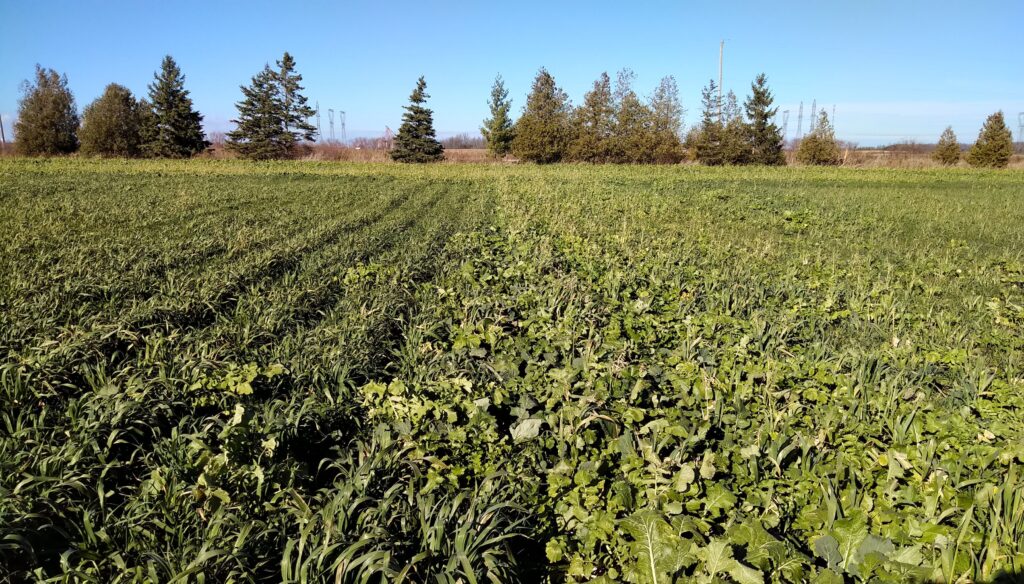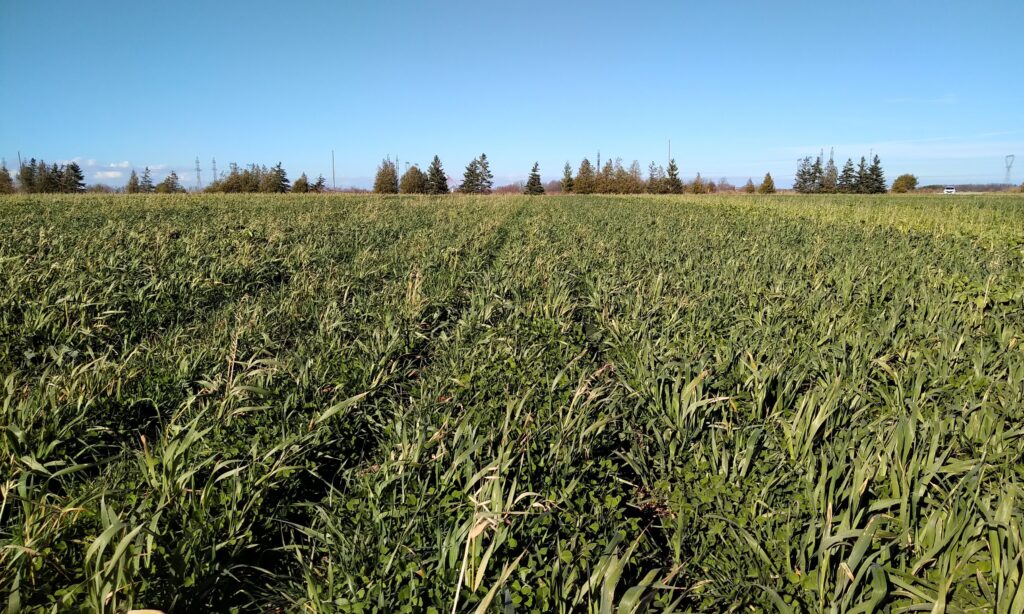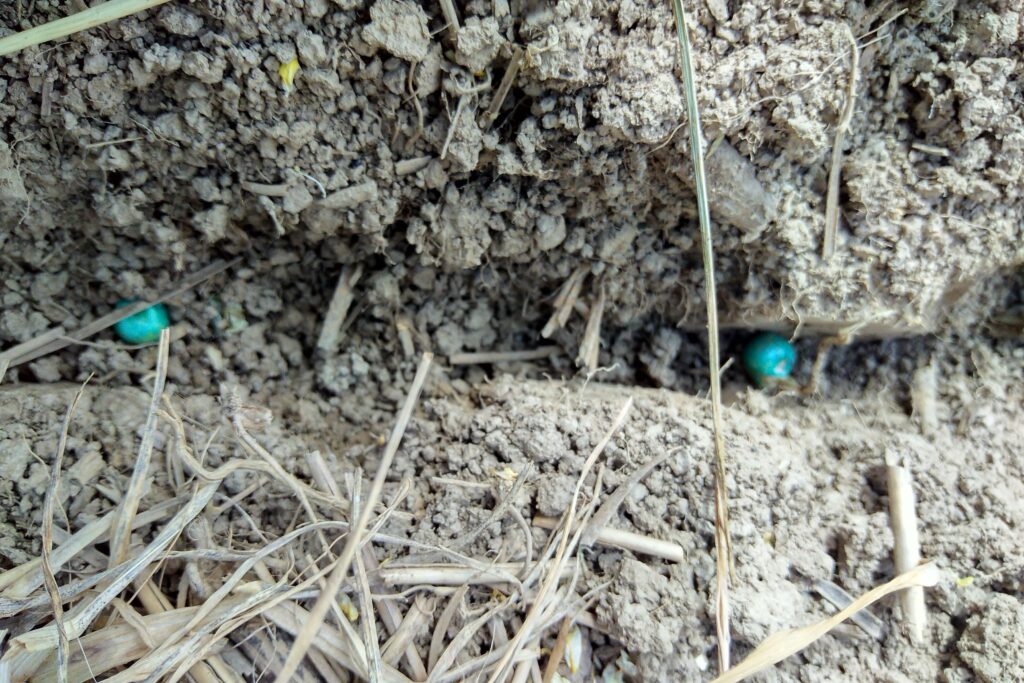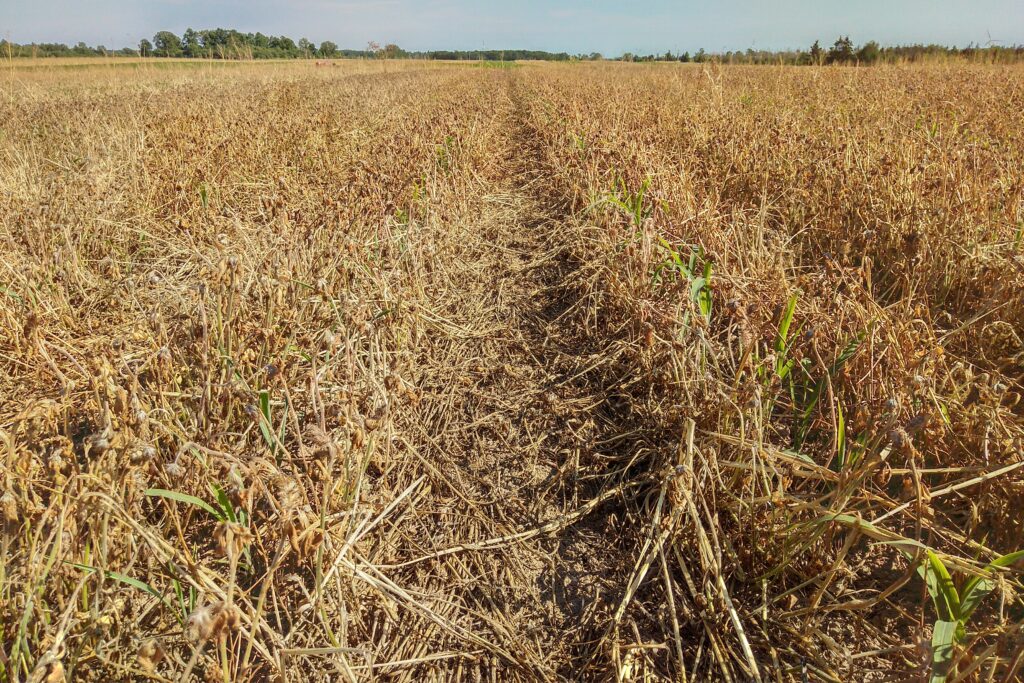This article shares the findings from a 2021 on-farm trial that compared fall cover crop termination with planting green. It was conducted near Hagersville, Ontario, as part of an Ontario Soil and Crop Improvement Association Tier Two project.
Highlights
- Three different overwintering cover crop treatments were compared to a fall-terminated cover crop mixture ahead of strip-tilled corn on a Haldimand silty clay.
- Corn yield was greatest where cover crops were fall-terminated. It was lowest when planted green into a crimson clover cover crop.
- Soil moisture depletion delayed corn germination and emergence and reduced final plant stand where cover crops were spring terminated.
- Fall termination of cover crops prior to corn in strip-till systems is recommended, particularly on heavy textured soils. Further research is needed to determine best practices to lower risk for overwintering cover crops ahead of corn.
To watch a short video with in-season footage from the trial, click below:
Background
Information on cover crop management often comes from research performed on loamy soils that are fairly forgiving. In this trial, we evaluated cover crops before corn on a challenging, silty clay soil in Haldimand County, Ontario. The purpose of the trial was to compare different overwintering cover crops to a fall-terminated control. The four treatments are shown below (Table 1).
Table 1. Treatment details, including cover crop species, seeding rate and date and termination.
| Treatment | Species | Seeding rate (lbs/ac) | Seeding date | Termination date |
| 1 | Cereal rye Oats Purple-top turnip Rape Radish | 22 14 1 1 2 | August 1, 2020 | Fall 2020 |
| 2 | Same as above | Same as above | Same as above | May 19, 2021 |
| 3 | Oats Austrian Winter Pea | 30 20 | August 9, 2020 | May 19, 2021 |
| 4 | Oats Crimson Clover | 30 20 | August 9, 2020 | May 19, 2021 |
Figure 1 (left) shows what treatment 2 (multispecies mixture) and treatment 3 (oats and Austrian winter pea) looked like in the fall, while Figure 1 (right) shows the crimson clover and oat mix (treatment 4). Each treatment had three replicates except for treatment 1, which only had two.

and treatment 3 (oats and Austrian winter peas; left)

Figure 1. Cover crop treatments on November 10, 2020.
Strip-tillage was performed in the fall of 2020 with a Dawn Pluribus to create a seedbed for corn planting in the spring of 2021. Corn was planted on May 18, 2021 into green, living cover crops in treatments 2-4, which were terminated by herbicide the next day. Nitrogen was applied at a rate of 191 lbs-N/acre over three applications.
Cover crop biomass was sampled on November 10, 2020 and again on May 14, 2021.
Results
Multispecies mixture provided most growth in fall
Cover crop biomass collected just prior to freeze-up in the fall of 2020 showed that the earlier-seeded multispecies mixture had the most growth, followed by treatment 4 (oats and crimson clover) (Table 2). Crimson clover established very well and accumulated over 1,300 lbs/ac of dry matter, compared to only 150 lbs/ac from Austrian winter peas.
Table 2. Fall biomass for cover crops from each treatment.
| Treatment | Brassicas (lbs/ac) | Legume (lbs/ac) | Oats (lbs/ac) | Volunteer wheat + rye (lbs/ac) | Total (lbs/ac) |
| 1 & 2 (multispecies mixture) | – | – | – | – | 2,804 |
| 3 (oats + Austrian winter pea) | n/a | 150 | 901 | 588 | 1,640 |
| 4 (oats + crimson clover) | n/a | 1,314 | 914 | 232 | 2,460 |
| Average | n/a | 732 | 908 | 410 | 2,301 |
Dense crimson clover stand in spring
By spring, volunteer wheat was quite thick in all treatments (Table 3). In treatment 1, rape, cereal rye, and some purple-top turnip came through winter. By mid-May, the brassicas were in flower (Figure 2). Crimson clover in treatment 4 survived winter very well and reached over one ton/acre of biomass before it was terminated. Austrian winter pea increased its biomass slightly compared to fall, but remained very sparse (Table 3).
Table 3. Spring biomass for cover crops from each treatment.
| Treatment | Brassicas (lbs/ac) | Legume (lbs/ac) | Cereal rye (lbs/ac) | Volunteer wheat (lbs/ac) | Total (lbs/ac) |
| 2 (multispecies mixture) | 1,753 | n/a | 1,224 | 962 | 3,939 |
| 3 (oats + Austrian winter pea) | n/a | 576 | n/a | 1,728 | 2,304 |
| 4 (oats + crimson clover) | n/a | 2,154 | n/a | 1,678 | 3,831 |
| Average | n/a | 1,365 | n/a | 1,456 | 3,358 |

Figure 2. Flowering brassica cover crops from treatment 2. May 14, 2021.
Planting green hurt corn stands and delayed development
All overwintering cover crop treatments (2, 3 and 4) depleted soil moisture in the days following seeding (Figure 3), despite corn being planted into moisture on May 18th. A ~1-inch rain on May 28th enabled germination of corn in those treatments; however, its development was delayed, and the stand was reduced relative to the cover crop-free treatment 1 (Table 4).

Figure 3. Dry, ungerminated corn seed in the trench of a cover crop treatment on May 27th, 2021, nine days after planting.
Crimson clover depleted soil moisture more substantially than the cover crops in treatments 2 and 3. Its dense root system also created challenges making a good seedbed with fall strip-tillage. It dried out soil strongly in mid-May and was slow to die with the herbicide mixture applied after planting (1.5 L Roundup + 2 L Acuron / acre). These challenges are reflected in the lowest corn stand, shortest plants, and most delayed corn in treatment 4 (Table 4).
Table 4. Average corn stand, growth stage and height by treatment. June 17th, 2021.
| Treatment | Avg. corn stand (plants/ac) | Avg. growth stage | Avg. height (in.) |
| 1 (multispecies mixture, fall-terminated) | 34,500 | V6 | 13 |
| 2 (multispecies mixture, spring-terminated) | 30,556 | V3.5 | 8.5 |
| 3 (oats + Austrian winter pea) | 30,444 | V3.5 | 8.2 |
| 4 (oats + crimson clover) | 28,556 | V2.5 | 6.6 |
Due to earlier germination, corn planted into treatment 1 (fall-terminated cover crop) had a significant advantage over corn planted green into cover crops in other treatments (Figure 4). Corn planted into crimson clover was the slowest to progress.


Figure 4. Corn growing in different treatments. June 17th, 2021.
Corn yields were lower in plant green treatments
Corn yield was greatest when cover crops were fall terminated (Table 5). Treatment 1 also tended toward lower grain moisture. Yields were not statistically different amongst treatments 2, 3 and 4, though crimson clover was the only treatment with an average yield below 200 bu/ac. It also had the lowest number of plants per acre with a cob at harvest (Table 5).
2021 was an excellent growing season, with ample precipitation throughout the later vegetative and reproductive growth stages. Without these favourable environmental conditions, it’s likely that the yield gap would have been much greater between treatment 1 and the three spring-terminated cover crop treatments.
Table 5. Average corn yield, moisture and number of plants per acre with a cob, based on hand harvesting. Values with the same letter in the same column are not statistically different (P<0.10). No statistics run on treatment 1, due to only two replications.
| Treatment | Avg. yield at 15.5% moisture (bu/ac) | Avg. moisture (%) | Avg. plants/acre with a cob at harvest |
| 1 (multispecies mixture, fall-terminated) | 225.5 | 33.2 | 32,269 |
| 2 (multispecies mixture, spring-terminated) | 207.7 A | 33.9 | 27,572 |
| 3 (oats + Austrian winter pea) | 210.5 A | 34.3 | 25,695 |
| 4 (oats + crimson clover) | 180.6 A | 34.6 | 22,651 |
| Average | 206.1 | 34.0 | 27,047 |
Take-aways
This trial highlighted the risks associated with overwintering cover crops and planting corn “green” into them in reduced tillage systems on clay soils. Based on differences in crop emergence and development, as well as yield trends, fall termination of cover crops was the best practice in this trial. Although cover crops can assist with drying soil out in the spring, they can dry soils excessively under some circumstances; this is especially true on heavy textured soils that can quickly go from being too wet to too dry (i.e. “three day clays”). The overwintering cover crop stands evaluated in this trial were seeded thick, with a significant added contribution from volunteer winter wheat. The risk associated with overwintering cover crops can be reduced by controlling volunteer wheat after harvest, using lower cover crop seeding rates, and terminating at least two weeks prior to corn planting.
Further trials are needed to evaluate best practices for managing overwintering cover crops on heavy textured soils. Although there are growers making plant green corn work on these soil types, for the time being, fall termination prior to corn planting is recommended.
More information
To read the full Crop Advance Report on this trial, visit OSCIA’s Crop Advances webpage: Evaluating overwintering cover crops – Part 1 Haldimand. To watch a short video profile of the trial, click here. A similar trial evaluating overwintering cover crops before corn in a strip-till system was conducted in 2021 and 2022 and results are reported in a separate Crop Advance Report: Evaluating overwintering cover crops – Part 2 Brant_Norfolk.
Thank you to General Seed for generously donating Austrian winter pea and crimson clover seed for the trial.
This project was funded in part by the Ontario Ministry of Agriculture, Food and Rural Affairs through the Canadian Agricultural Partnership, a five-year federal-provincial-territorial initiative.